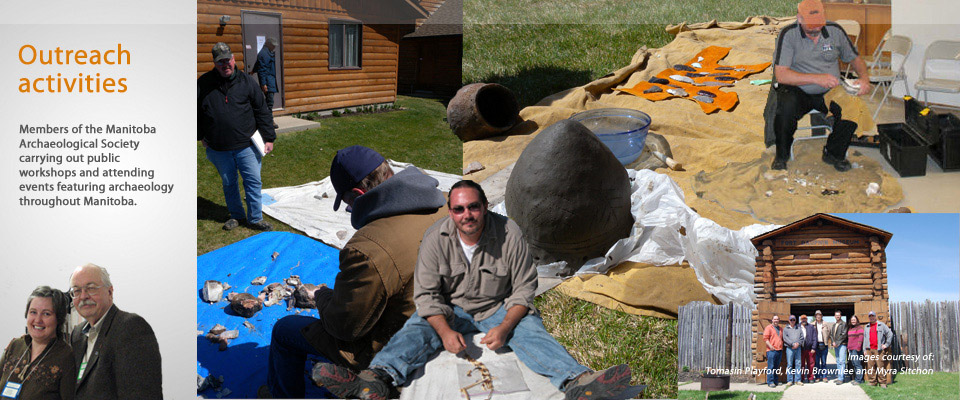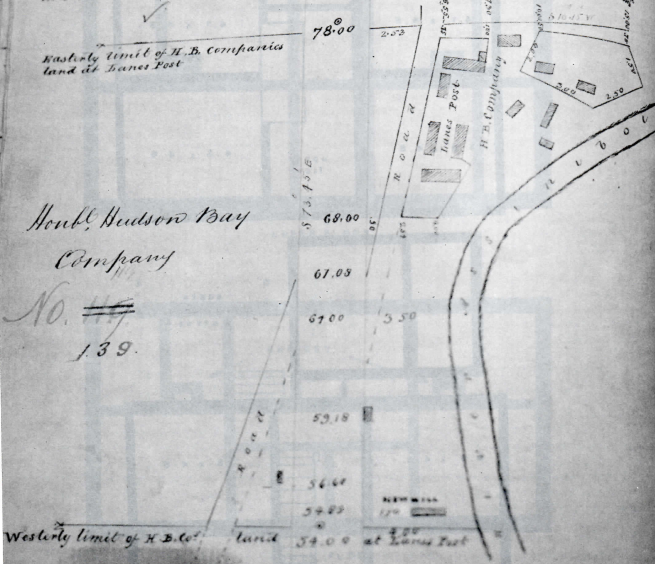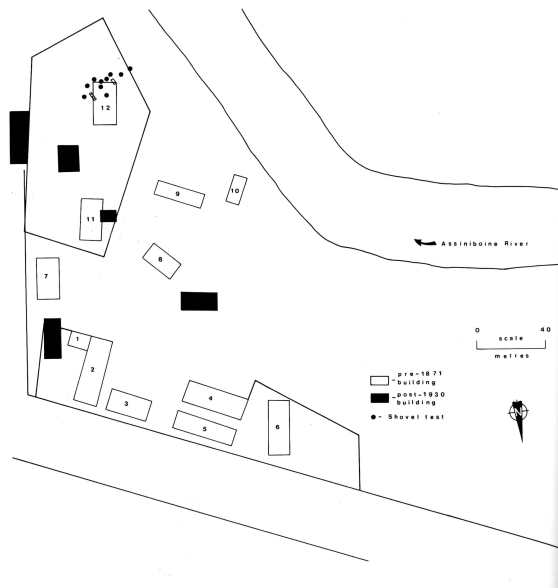Lane's Post
|
Between the 1830s and mid-1850s, the Red River Settlement received most provisions from London and often suffered chronic food shortages. In response, the Hudson’s Bay Company (HBC) established several experimental farms to provide a more reliable supply of less expensive food. In 1855, one of these farms was established along a cart trail on River Lot 139 in the Parish of St. Francois Xavier. By 1858, Lane’s Post was a successful fur trading post and livestock operation. The post bears the name of William Douglas Lane, who was its master between 1855 and 1874. By the mid-1870s, fifteen buildings had been constructed on the lot, including a dairy, storehouse, mess house, kitchen, carpenter’s shop, clerk’s room, Mr. Lane’s house, McLeod’s house, men’s house, harness room, granary and forge (Figure 1). Afterwards, a mill was built. Twelve buildings were erected on the east side of the lot and three were built on the west. The post remained open until 1883. The buildings were constructed from squared logs fitted together using the mortise and tenon technique. According to a list of supplies ordered in 1860, some of buildings were made from 10 ft (3 m) long poplar and oak logs; planks and boards used as siding and flooring were white wood (probably pine or spruce). Two separate enclosures, constructed from the 3000 poplar fencing posts acquired in 1860, surrounded some of the buildings. |
Figure 1. Dominion Land Survey drawing of Lane's Post in 1871 (from McLeod and Seyer 1988) |
|
Figure 2. Map showing former and existing structures at the site and 1986 test excavations (from McLeod and Seyers 1988) |
Manitoba Historic Resources Branch excavations at Lane’s Post were in response to a 1986 proposal by the St. Francis Xavier Historical Society. It began with a search for the five buildings constructed along the cart path (which later became Provincial Trunk Highway 26). The area was extensively disturbed by more recent construction activities and little evidence of those buildings was found. Archaeologists had more success locating structures situated closer to the Assiniboine River. A shovel test placed at a concentration of wrought iron and machine cut nails encountered a squared sill log oriented in an east-west direction about 20 cm below the surface. Excavations conducted on the inside of the building, identified as Structure 12 in Figure 2, revealed additional sill logs and the remains of a cellar. This building was a storehouse situated near the river to facilitate the movement of goods along the waterway. The remains of Structure 12 were covered with a layer of organic rich soil at the surface and flood deposits. Inside the building, a 30-35 cm thick layer of chinking, material used to fill gaps between the logs and make the structure more weather-resistant, covered a thin organic band, believed to the rotten remains of floorboards. Below this, excavators encountered a shallow layer of black clay; no artifacts were found in the grey silty clay found underneath it. |
Artifact recoveries were analyzed on the basis of where they were found and their function. Most artifacts were recovered inside of Structure 12, either in or above the chinking layer (Zone A) or below it (Zone B). Zone B artifacts were likely associated with activities that occurred while the post was in operation; Zone A artifacts were likely deposited after the post was closed but before the building was dismantled. Artifacts recovered in test pits were analyzed separately.
Most artifacts from the chinking layer and above (Zone A) consisted of construction hardware and nails. Similar artifact frequencies were encountered in the test pits. This distribution likely related to how the building was dismantled. Construction hardware, nails and window glass were probably discarded at the site before the useable lumber was take away. Zone B recoveries largely consisted of nails, bone fragments and window glass but other artifact classes appeared with higher frequency. Artifacts associated with kitchen activities included fragments of kitchenware, various types of ceramics, glassware and bottles (medicine, liquor bottles and other types). Buttons, pins and beads lost from clothing, fragments of a stove, a few personal items (a slate board, toothpaste container, hair pin), smoking pipe fragments, construction tools, and miscellaneous hardware were also recovered from Zone B.
The types of nails recovered provided important information about the construction of the building. About 60 percent of the nails directly associated with Structure 12 were hand-wrought, a type commonly used before 1860. This indicates the building was erected shortly after the post was established. Machine cut nails, most commonly used between 1860 and 1900, were mainly found in the test pits. The wide variety of artifacts recovered is consistent with its use as a storehouse of materials shipped to the post.
Reference:
McLeod, K. D. and Linda Seyers
1988 Archaeological research at Lane’s Post on River Lot 139, Parish of St. Francois Xavier. Manitoba Archaeological Quarterly 12 (3): 3-32.






